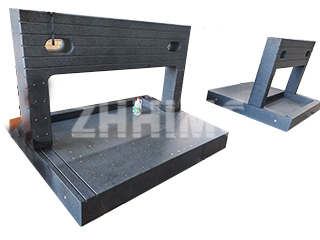At ZHHIMG®, we specialize in manufacturing granite components with nanometer precision. But true precision extends beyond the initial manufacturing tolerance; it encompasses the long-term structural integrity and durability of the material itself. Granite, whether used in precision machine bases or large-scale construction, is susceptible to internal defects like micro-cracks and voids. These imperfections, combined with environmental thermal stress, directly dictate a component’s longevity and safety.
This demands advanced, non-invasive assessment. Thermal Infrared (IR) Imaging has emerged as a crucial Nondestructive Testing (NDT) method for granite, providing a rapid, non-contact means to assess its internal health. Coupled with Thermo-Stress Distribution Analysis, we can move beyond simply finding a defect to truly understanding its impact on structural stability.
The Science of Seeing Heat: IR Imaging Principles
Thermal IR imaging works by capturing the infrared energy radiated from the granite surface and translating it into a temperature map. This temperature distribution indirectly reveals underlying thermophysical properties.
The principle is straightforward: internal defects act as thermal anomalies. A crack or void, for instance, impedes the flow of heat, causing a detectable difference in temperature from the surrounding sound material. A crack might appear as a cooler streak (blocking heat flow), while a highly porous region, due to differences in heat capacity, might show a localized hot spot.
Compared to conventional NDT techniques like ultrasonic or X-ray inspection, IR imaging offers distinct advantages:
- Rapid, Large-Area Scanning: A single image can cover several square meters, making it ideal for the swift screening of large-scale granite components, such as bridge beams or machine beds.
- Non-Contact and Nondestructive: The method requires no physical coupling or contact medium, ensuring zero secondary damage to the pristine surface of the component.
- Dynamic Monitoring: It allows for the real-time capture of temperature change processes, essential for identifying potential thermally induced defects as they develop.
Unlocking the Mechanism: The Theory of Thermo-Stress
Granite components inevitably develop internal thermal stresses due to ambient temperature fluctuations or external loads. This is governed by the principles of thermoelasticity:
- Thermal Expansion Mismatch: Granite is a composite rock. Internal mineral phases (such as feldspar and quartz) have differing thermal expansion coefficients. When temperatures change, this mismatch leads to non-uniform expansion, creating concentrated zones of tensile or compressive stress.
- Defect Constraint Effect: Defects like cracks or pores inherently constrain the release of localized stress, causing high-stress concentrations in the adjacent material. This acts as an accelerator for crack propagation.
Numerical simulations, such as Finite Element Analysis (FEA), are essential for quantifying this risk. For instance, under a cyclic temperature swing of 20°C (like a typical day/night cycle), a granite slab containing a vertical crack can experience surface tensile stresses reaching 15 MPa. Given that granite’s tensile strength is often less than 10 MPa, this stress concentration can cause the crack to grow over time, leading to structural degradation.
Engineering in Action: A Case Study in Preservation
In a recent restoration project concerning an ancient granite column, thermal IR imaging successfully identified an unexpected annular cold band in the central section. Subsequent drilling confirmed this anomaly was an internal horizontal crack.
Further thermo-stress modeling was initiated. The simulation revealed that peak tensile stress within the crack during summer heat reached 12 MPa, dangerously exceeding the material’s limit. The required remediation was a precision epoxy resin injection to stabilize the structure. A post-repair IR check confirmed a significantly more uniform temperature field, and stress simulation validated that the thermal stress was reduced to a safe threshold (below 5 MPa).
The Horizon of Advanced Health Monitoring
Thermal IR imaging, combined with rigorous stress analysis, provides an efficient and reliable technical pathway for the Structural Health Monitoring (SHM) of critical granite infrastructure.
The future of this methodology points toward enhanced reliability and automation:
- Multi-Modal Fusion: Combining IR data with ultrasonic testing to improve the quantitative accuracy of defect depth and size assessment.
- Intelligent Diagnostics: Developing deep-learning algorithms to correlate temperature fields with simulated stress fields, enabling the automatic classification of defects and predictive risk assessment.
- Dynamic IoT Systems: Integrating IR sensors with IoT technology for real-time monitoring of thermal and mechanical states in large-scale granite structures.
By non-invasively identifying internal defects and quantifying the associated thermal stress risks, this advanced methodology significantly extends component lifespan, providing scientific assurance for heritage preservation and major infrastructure safety.
Post time: Nov-05-2025

